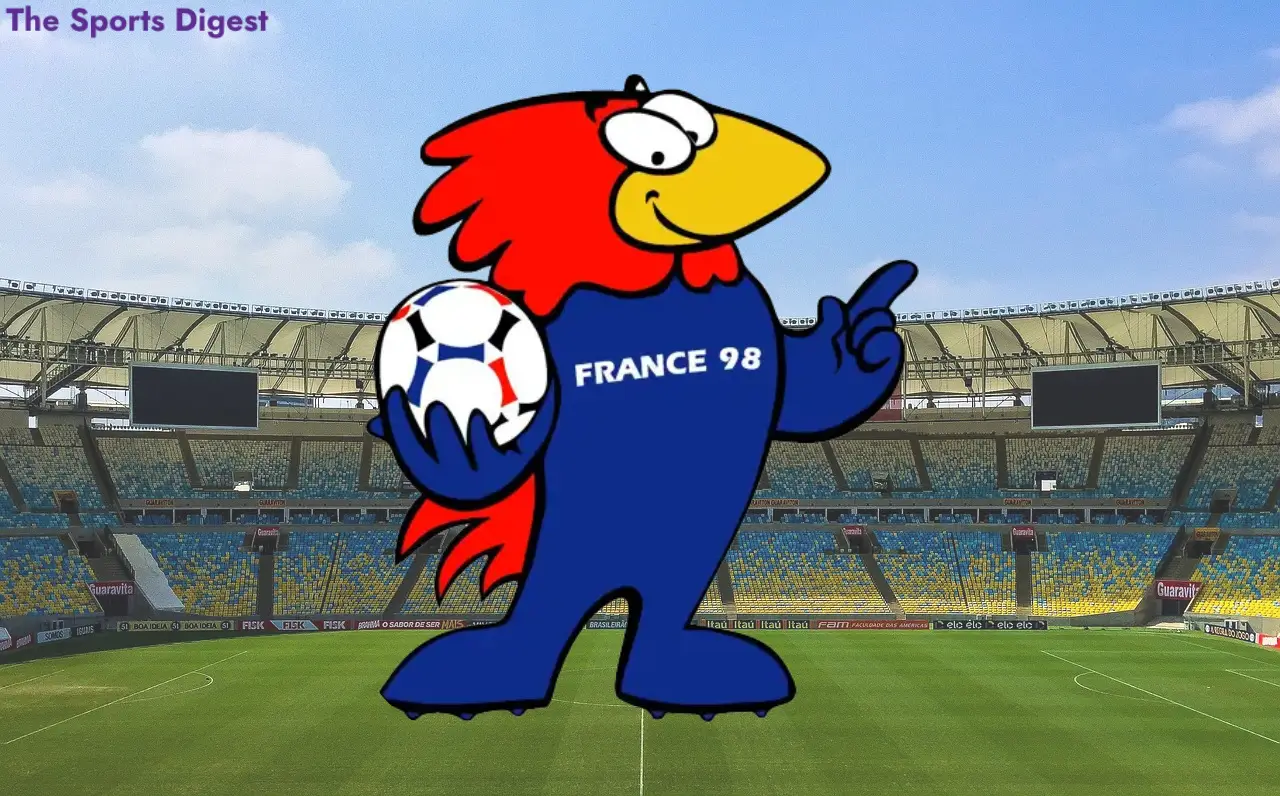Footix: The 1998 World Cup Mascot
The 1998 World Cup, held in France, featured an essential mascot, “Footix the Rooster.” The rooster, a prominent national symbol in France, represents not only football but also French culture as a whole.
Footix the Rooster was an innovative design created by French designer Fabrice Pialot, and it was first introduced in 1996. It was chosen through a vote by French television viewers. The mascot’s name is composed of two parts: “Foot,” which means “foot” in English, and “-ix,” which is derived from the famous cartoon “Asterix” (Astérix). The rooster was designed in a way that closely resembled the French national team, as it was blue, the same color as the French team’s kit. The word “France 98” was written on its body in white, strongly connecting it to the tournament.
Footix the Rooster became a symbol that reflected France’s culture and its history in sports, especially football, and is considered one of the most memorable mascots in World Cup history.
Table of Contents
Stadiums and Venues for the 1998 World Cup
The stadiums that host the matches in the World Cup play a crucial role in the success of the tournament. Therefore, France had to ensure that its stadiums met the highest standards to welcome the teams and fans. When France applied to host the World Cup, it already had a national stadium capable of hosting 80,000 spectators, which was a positive factor for the bid. However, France did not stop there, as nine additional stadiums were selected to be part of the event.
After France won the bid to host the tournament, it was discovered that many of the stadiums did not meet FIFA’s criteria. According to FIFA’s regulations, each stadium must have a seating capacity of at least 40,000 spectators. Despite these challenges, France worked hard to upgrade the stadiums and improve their facilities. The development process took about 26 months, and contractors and specialists worked continuously to prepare the stadiums in record time. By November 1997, the preparations were completed at a cost of 2.67 billion French francs.
A total of 10 stadiums were chosen from among many across 14 host cities. The “Stade de France” in Saint-Denis hosted the opening ceremony and the first match of the tournament, while “Parc des Princes” in Paris hosted the final match. These stadiums played a significant role in delivering high-level football and contributed to the organization and success of the tournament.
Qualification for the 1998 World Cup
The qualification process for the 1998 World Cup is one of the exciting events leading up to the tournament, as teams from all around the world compete for their spots in the tournament. For the 1998 World Cup, the qualification draw took place in Paris on December 12, 1995. This tournament saw an increase in the number of participating teams, with the number being raised to 32 teams, opening the door for more teams to participate in the prestigious event.
France did not need to qualify as it was the host country, and Brazil, as the defending champion, was also exempt from qualifying. Despite this, the qualification rounds were held across various regions, with teams competing for 31 spots to join France in the tournament. Strong teams like Argentina, Germany, Italy, and Spain participated, and there were also some surprises, with some teams qualifying for the first time in their history, which added excitement to the competition.
List of Referees for the 1998 World Cup
Referees are an essential part of any sports tournament, especially in the 1998 World Cup, where they ensure that the matches are played according to the rules. A total of 34 referees and 33 assistant referees were selected for the 1998 World Cup, which was an increase compared to the previous tournament. This increase was due to the large number of matches and the expanded tournament with 32 teams.
The referees were selected from several continental football associations, with 5 from the African Football Confederation, 4 from the Asian Football Confederation, 15 from the European Football Association, 3 from CONCACAF, 1 from the Oceania Football Confederation, and 6 from CONMEBOL. These referees were chosen based on their experience and competence in international tournaments. Here are some of the prominent referees selected for the tournament:
African Football Confederation (5 referees):
- Morocco: Saïd Belqola
- Egypt: Gamal Al-Ghandour
- Niger: Lousin Bouchardeau
- Mauritius: Lim Kee Chong
- South Africa: Ian McLeod
Asian Football Confederation (4 referees):
- Saudi Arabia: Abdulrahman Al-Zaid
- United Arab Emirates: Ali Bujsaim
- Japan: Masayoshi Okada
- Thailand: Perom Anprasert
European Football Association (15 referees):
- France: Marc Batta
- Austria: Günter Benkö
- Italy: Pierluigi Collina
- Scotland: Hugh Dallas
- England: Paul Durkin
- Spain: Garcia Aranda
- Germany: Bernd Heinemann
- Russia: Nikolai Levnikov
- Switzerland: Urs Meier
- Portugal: Melo Pereira
- Denmark: Kim Milton Nielsen
- Norway: Rune Pedersen
- Hungary: Laszlo Venger
- Netherlands: Van der Ende
- Poland: Richard Wigwick
CONCACAF (3 referees):
- United States: Esfandiar Baharmast
- Mexico: Aritero Carter
- Trinidad and Tobago: Ramesh Ramdhan
Oceania Football Confederation (1 referee):
- Australia: Eddie Lennie
CONMEBOL (6 referees):
- Argentina: Javier Castrilli
- Paraguay: Epifanio Gonzalez
- Brazil: Marcelo de Freitas
- Chile: Mario Sanchez
- Peru: Alberto Noriega
- Colombia: John Rendon
These referees played a key role in ensuring the fairness and integrity of the tournament, as they oversaw matches from start to finish with professionalism and expertise.
Conclusion
The 1998 World Cup in France was an unforgettable tournament that brought many historic moments. From the selection of the mascot “Footix the Rooster,” which became part of France’s national identity, to the impressive stadiums that represented the spirit of the tournament, to the thrilling qualification process that allowed for the emergence of new teams, and the selection of world-class referees who managed the matches with professionalism—France succeeded in organizing an outstanding sporting event.
The 1998 World Cup was one of the most successful tournaments in football history, leaving a lasting impact on fans around the world. The event not only showcased some of the best football but also symbolized the unity and excitement that international competitions bring to the global stage.
Have you ever read an article like this?
There are no reviews yet. Be the first one to write one.






